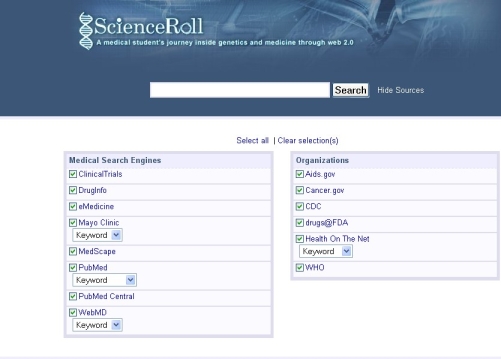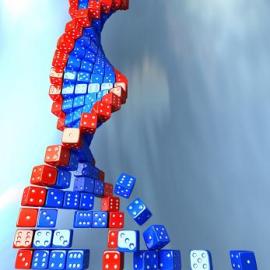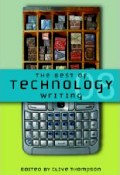The DNA Network |
| Uploading your data to iFinch [FinchTalk] Posted: 17 Oct 2008 02:05 PM CDT |
| Customize Medical Search with ScienceRoll [ScienceRoll] Posted: 17 Oct 2008 01:44 PM CDT The recent relative lack of posts is due to my upcoming neurology exam. Only a week left, so fingers crossed… But here is a new post mentioning Scienceroll Search, our personalized medical search engine.
 |
| Direct-to-consumer genetic testing in trouble [ScienceRoll] Posted: 17 Oct 2008 01:26 PM CDT Have you seen the new FDA warning letter?
Further reading:  |
| Punished with grandchildren [Mary Meets Dolly] Posted: 17 Oct 2008 12:29 PM CDT When Barack Obama said he didn't want his daughters to be "punished" with an unwanted baby, he lost my vote. I had a crisis pregnancy in college and a baby is never a "punishment." Ever. This ad takes it even further. Thanks Pro-life Blogs. |
| Visit the Galápagos for free! (as an avatar) [Discovering Biology in a Digital World] Posted: 17 Oct 2008 11:18 AM CDT The Galápagos islands rank high on my list of places that I really, really, really want to visit. But for many reasons, it's always looked like a trip to the Galápagos would be at least a decade or two away. Now, I'll be able to go in January and so will all of you. Read the rest of this post... | Read the comments on this post... |
| Blocked Access Bummer #1 [The Tree of Life] Posted: 17 Oct 2008 09:37 AM CDT I have decided to start posting when I want to read an article at home but cannot due to lack of access (even though I might have it at work). Today's bummer is I wanted to read an article by Joel Sachs on "Resolving the first steps to multicellularity" but I could not get it because I do not have access to Trends in Ecology and Evolution at home. Bummer. Looks like it could be good. |
| The cloning conundrum [Mary Meets Dolly] Posted: 17 Oct 2008 08:07 AM CDT I refuse to let this one go. Sorry. Good: cloning humans to harvest genetically engineered cells to inject into the human body. Bad: cloning animals to produce healthier food products. Good: injecting cloned stem cells straight into blood stream or brain. Bad: drinking milk from cloned cow. I am confused. Are you? |
| Science Books [Sciencebase Science Blog] Posted: 17 Oct 2008 07:00 AM CDT
First up is Go Green - How to Build an Earth-Friendly Community, which you will be pleased to learn has been published on apparently sustainable paper. The author, Nancy Taylor, is an environmental columnist and teaches a course on the art of green living. Her book does what it says on the tin (also recyclable, other metals are available), offering advice for those who want to change the way they live to be more in line with a sustainable future. Homeowners, students, professionals could do well to take a look and learn how to live greener lives. Politicians should also take a look, as at the bottom line, Taylor could show them how to save money. And, speaking of green, fuel cells are apparently the future. Gavin Harper, in Fuel Cell Projects for the Evil Genius explains how they work and how you could make and test a simple fuel cell. Next up is Ad Lagendijk’s Survival Guide for Scientists. In a scientific world, steadily growing virtual, it’s reassuring to know that some of the old principles of good writing, preparing a research paper, putting up a poster presentation, corresponding with fellow scientists, and giving a talk, are still valid. It’s not all flickering comments on Twitter and Feedfriend after all. The Guide is aimed primarily at undergraduates, grad students, and postdocs in the natural sciences and offers a practical howto on the foundations of writing, presenting and researching science. A Short Guide to the Human Genome from Stewart Scherer attempts to answer some of the basic questions about genetics. How many genes are there in the human genome? Which genes are commonly associated with disease? What are the biggest genes? How close is the human genome to the mouse, yeast, bacteria? Stem Cells, Human Embryos and Ethics edited by Lars Ostnor attempts to define whether it is acceptable from an ethical, as opposed to scientific standpoint, to use stem cells harvested from human embryos for biomedical research or as treatments for sick patients. This advanced book provides a brief introduction to the emerging technologies and a basis for wider debate. From inner space to nearby outer space, Ralph Lorenz and Jacqueline Mitton take us on a tour of Saturn’s mysterious moon in Titan Unveiled. This is the first authoritative book to look at the data from the Cassini-Huygens probe sent to observe one of the largest moon’s in the solar system, Titan. Staying with astronomy, but taking a much broader cosmological view, Leonard Susskind tells us of his battle with Stephen Hawking to make the world safe for quantum mechanics in The Black Hole War. With nothing less than an understanding of the entire universe at stake it was essential that the argument over the true nature of black holes between Susskind, Hawking, and Gerard ‘t Hooft be won, one way or the other, so that we can know what happens ultimately to someone sucked into a black hole. Finally, just arrived is this year’s Best of Technology Writing, edited by Clive Thompson. If this is anything like the previous two editions then it is a feast of great technology writing from my peers across the pond. It carries a fascinating mix of topics from a molecular recipe for the perfect gin & tonic to an ancient Greek artifact that may have been the world’s first laptop computer. |
| Well, at least I got a lot of traffic out of the deal… [Mailund on the Internet] Posted: 17 Oct 2008 03:44 AM CDT |
| Update on my swapping woes [Mailund on the Internet] Posted: 17 Oct 2008 03:35 AM CDT I feel a bit embarrased about the ranting and complaining about Linux yesterday, ’cause as it turned out and as suggested by most of the commenters, on Linux you actually have the tools to fix the system when it is broken. And broken it was, but only on my box. The comment that sent me down the path to solving the problem was this one:
See, at the time I thought my problem was that the system was swapping way too much, to the point where I couldn’t get in contact with it. That is how it behaved. It would run out of RAM, the disk would be spinning, it would slow down to the point where I couldn’t interact with the machine. So reducing swapping might crash some programs if they run out of memory, but at least I would be able to interact with the system. Sounded like just the thing to go for. Well, when I followed the instructions I came to this command, with this troubling error: $ sudo swapoff -a swapoff: cannot canonicalize /dev/disk/by-uuid/d00bfdb4-c541-4d56-8448-b0a13ce352a8: No such file or directory Ups, something is wrong here. Could it be that the system doesn’t know where the swap partition is? I checked the system monitor and to my horror found that it uses 0 bytes of swap, even when I am trying to fill up the RAM with all the applications I can fire up. Yep, something is wrong here. I googled for “swapoff: cannot canonicalize” — I find that googling the error message usually leads me to the answer faster than actually thinking about it — and then I hit this thread: http://ubuntuforums.org/showthread.php?t=802398 I followed the advice there and update /etc/fstab and viola, my swapping is back up (well, after running swapon -a). If I stress the system now, of course some tools slow down as they are swapped out, but the behaviour is no where near what it was earlier. Why the symptoms earlier looked like swapping rather than crashing applications I don’t know, but I don’t really care either. I’m just happy to have a stable system back. Sorry for ranting, Linux, in the end you came through for me :) |
| Thinking big, thinking long [business|bytes|genes|molecules] Posted: 16 Oct 2008 11:37 PM CDT
Venture Hacks highlights an interview with Vinod Khosla, where he talks about big opportunities, multi-billion dollar markets. The kind of change that literally impacts how we live. Wait, there’s more
You know what. Those who fund science could learn a thing or two from Mr. Khosla Related articles by Zemanta
|
| Larry Moran on Phylogenomics, my new paper, and species [The Tree of Life] Posted: 16 Oct 2008 09:50 PM CDT Just a quick note to encourage people to check out Larry Moran at The Sandwalk blogging about my new phylogenomics paper (with Martin Wu) and talking about whether one can use species as a term for bacteria. |
| Using Evolution to Predict Disease Mutations [adaptivecomplexity's column] Posted: 16 Oct 2008 09:36 PM CDT As many readers here know, evolution isn't just some esoteric topic disconnected from the rest of biology. It's a core theory that is underlies all of biology. Today our department heard a talk from Dr. Sudhir Kumar, a U of Arizona scientist who is using evolutionary theory to improve our ability to predict which mutations are likely to cause disease (PDF). |
| Life is for the living? [Mary Meets Dolly] Posted: 16 Oct 2008 06:23 PM CDT This movie is misnamed. It is called "Life is for the Living". It should be called, "Life is for Those Deemed Worthy to Live." Embryos are living too, just not worthy of finishing out their lives according to those who made this film. Once again it seems embryos have a duty to die. |
| UN reconsiders human cloning [Mary Meets Dolly] Posted: 16 Oct 2008 11:03 AM CDT In 2005, the United Nations said "NO" to human cloning for any reason. They rightly saw that human cloning, even for therapeutic reasons was "incompatible with human dignity and protection of life." According to the UN website they are reconsidering their stance:
I am sure they got it right the first time. But if the UN wants to revisit the issue, fine. But the real issue is why they want to revisit human cloning. Let me give it to you again:
What developments? In the last three years what significant "advances" have been made in the field of therapeutic cloning treating patients? So someone in Southern California finally cloned a human embryo and extracted stem cells. No patient is any closer to getting treated with stem cells made from human cloning. Patients are much closer to getting treated with their own stem cells with no cloned embryos and no human eggs needed. Considering the Pandora's Box that therapeutic cloning may open, including the exploitation of poor women for their eggs, I am surprised the UN would reconsider their stance with no evidence that human cloning will ever surpass adult stem cells in treating patients. This may be once again prove that if the politicians, special interests and the media repeat that therapeutic cloning is the "most promising stem cell research" enough, then it suddenly becomes a reality. I sure hope the UN does not fall for it.
|
| You are subscribed to email updates from The DNA Network To stop receiving these emails, you may unsubscribe now. | Email Delivery powered by FeedBurner |
| Inbox too full? | |
| If you prefer to unsubscribe via postal mail, write to: The DNA Network, c/o FeedBurner, 20 W Kinzie, 9th Floor, Chicago IL USA 60610 | |


 Once again, I have a stack of great books sitting on the Sciencebase desk ready for review.
Once again, I have a stack of great books sitting on the Sciencebase desk ready for review.

![Reblog this post [with Zemanta]](http://img.zemanta.com/reblog_b.png?x-id=41e7121f-dc70-4e32-a9f3-aac6afc33a43)
No comments:
Post a Comment